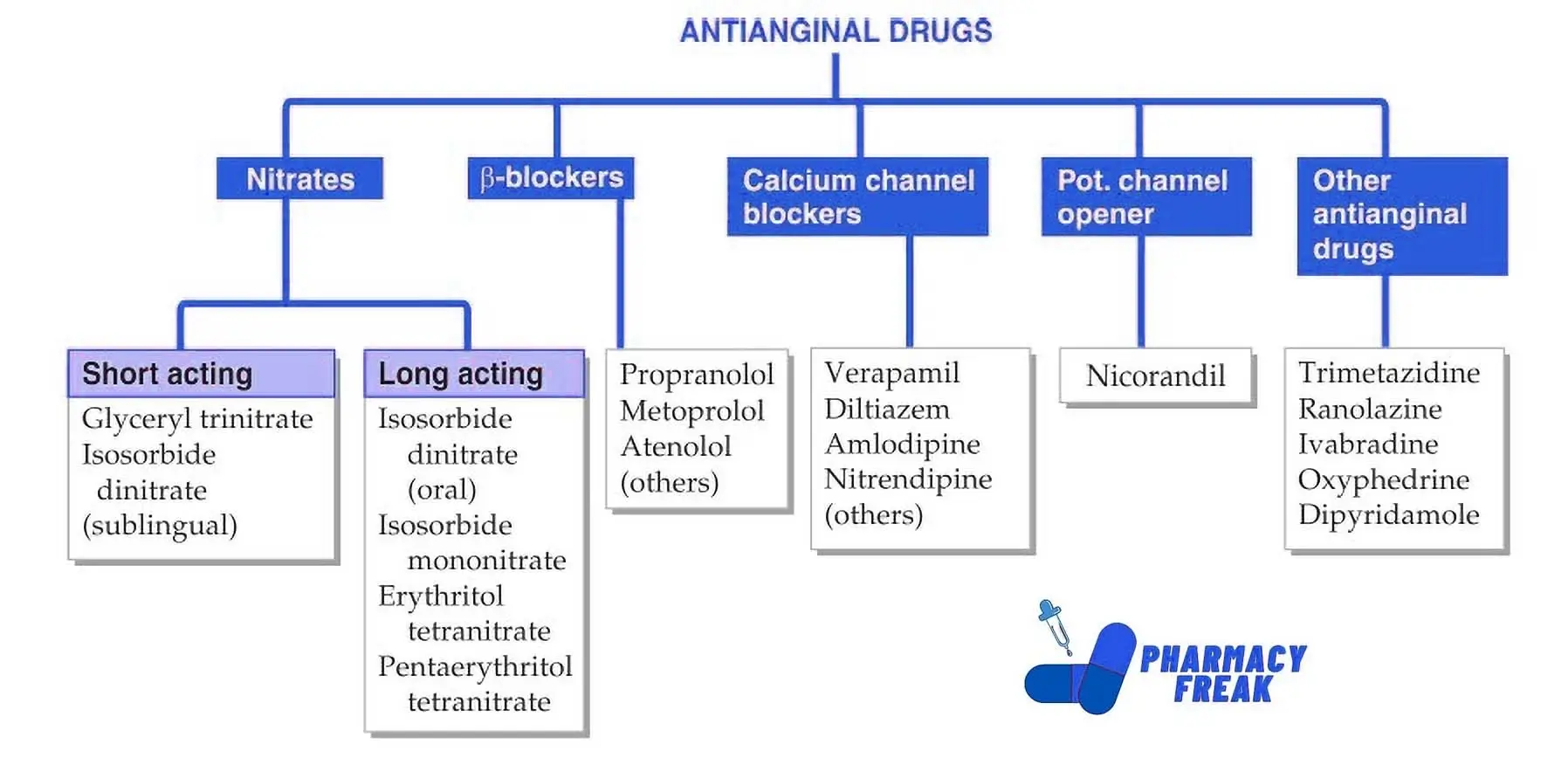Antianginal drugs are a group of medications that play a vital role in the management of angina pectoris, a medical term for chest pain or discomfort caused by reduced blood flow to the heart muscle. These drugs are essential in alleviating symptoms and improving the overall well-being of individuals with angina. Let’s explore the different types of antianginal drugs and how they help manage this condition.
Table of Contents
Classification of Antianginal Drugs
There are several classes of antianginal drugs, each with its unique mechanisms of action:
- Nitrates
- Short-acting– Glyceryl, trinitrate, Isosorbide, dinitrate (sublingual)
- Long-acting– Isosorbide dinitrate (oral), Isosorbide mononitrate, Erythritol tetranitrate, Pentaerythritol tetranitrate
- β-blockers– Propranolol, Metoprolol, Atenolol (others)
- Calcium channel blockers- Verapamil, Diltiazem, Amlodipine, Nitrendipine (others)
- Pot. channel opener- Nicorandil
- Other antianginal drugs– Trimetazidine, Ranolazine, Ivabradine, Oxyphedrine, Dipyridamole
- Nitrates:
- Nitrates, such as nitroglycerin, are vasodilators. They work by relaxing the blood vessels, particularly the veins, which decreases the heart’s workload and oxygen demand. This leads to improved blood flow and reduced chest pain.
- Beta-Blockers:
- Beta-blockers, like metoprolol and atenolol, reduce the heart’s workload by slowing the heart rate and reducing its contractility. This results in less oxygen demand by the heart muscle, making them effective in preventing angina.
- Calcium Channel Blockers:
- Calcium channel blockers, such as amlodipine and diltiazem, dilate coronary arteries and decrease the force of heart contractions. By doing so, they enhance blood flow to the heart and decrease the occurrence of anginal episodes.
- Potassium Channel Activators:
- These drugs, like nicorandil, help dilate the coronary arteries and improve blood flow to the heart. They also have a vasodilating effect on veins.
- Ranolazine:
- Ranolazine works by decreasing the late sodium current in heart cells. This results in improved diastolic relaxation and increased coronary blood flow, reducing angina symptoms.
- Combination Therapy:
- Sometimes, healthcare providers prescribe a combination of two or more antianginal drugs to achieve better symptom control. For example, nitrates and beta-blockers may be used together to manage angina effectively.
Common Uses of Antianginal Drugs
Angina pectoris is the primary condition these drugs are used to treat. This condition manifests as chest pain or discomfort due to the heart not receiving enough oxygen-rich blood. Antianginal drugs help in the following ways:
- Relieving Chest Pain: The most immediate benefit of these drugs is the relief of chest pain or discomfort during an anginal episode.
- Preventing Angina: By reducing the heart’s workload and oxygen demand, these drugs can help prevent anginal episodes from occurring.
- Improving Exercise Tolerance: Some antianginal drugs can enhance an individual’s ability to engage in physical activity without experiencing chest pain.
Reference
- Classification of Progestins- KD Tripathi
- National Library of Medicine- Hemodynamic profiles of antianginal agents
Related Links

I am a Registered Pharmacist under the Pharmacy Act, 1948, and the founder of PharmacyFreak.com. I hold a Bachelor of Pharmacy degree from Rungta College of Pharmaceutical Science and Research. With a strong academic foundation and practical knowledge, I am committed to providing accurate, easy-to-understand content to support pharmacy students and professionals. My aim is to make complex pharmaceutical concepts accessible and useful for real-world application.
Mail- Sachin@pharmacyfreak.com
